 |
| AP Board Class 7 Science Chapter 8 Air Winds and Cyclones Textbook Solutions PDF: Download Andhra Pradesh Board STD 7th Science Chapter 8 Air Winds and Cyclones Book Answers |
Andhra Pradesh Board Class 7th Science Chapter 8 Air Winds and Cyclones Textbooks Solutions PDF
Andhra Pradesh State Board STD 7th Science Chapter 8 Air Winds and Cyclones Books Solutions with Answers are prepared and published by the Andhra Pradesh Board Publishers. It is an autonomous organization to advise and assist qualitative improvements in school education. If you are in search of AP Board Class 7th Science Chapter 8 Air Winds and Cyclones Books Answers Solutions, then you are in the right place. Here is a complete hub of Andhra Pradesh State Board Class 7th Science Chapter 8 Air Winds and Cyclones solutions that are available here for free PDF downloads to help students for their adequate preparation. You can find all the subjects of Andhra Pradesh Board STD 7th Science Chapter 8 Air Winds and Cyclones Textbooks. These Andhra Pradesh State Board Class 7th Science Chapter 8 Air Winds and Cyclones Textbooks Solutions English PDF will be helpful for effective education, and a maximum number of questions in exams are chosen from Andhra Pradesh Board.Andhra Pradesh State Board Class 7th Science Chapter 8 Air Winds and Cyclones Books Solutions
| Board | AP Board |
| Materials | Textbook Solutions/Guide |
| Format | DOC/PDF |
| Class | 7th |
| Subject | Maths |
| Chapters | Science Chapter 8 Air Winds and Cyclones |
| Provider | Hsslive |
How to download Andhra Pradesh Board Class 7th Science Chapter 8 Air Winds and Cyclones Textbook Solutions Answers PDF Online?
- Visit our website - Hsslive
- Click on the Andhra Pradesh Board Class 7th Science Chapter 8 Air Winds and Cyclones Answers.
- Look for your Andhra Pradesh Board STD 7th Science Chapter 8 Air Winds and Cyclones Textbooks PDF.
- Now download or read the Andhra Pradesh Board Class 7th Science Chapter 8 Air Winds and Cyclones Textbook Solutions for PDF Free.
AP Board Class 7th Science Chapter 8 Air Winds and Cyclones Textbooks Solutions with Answer PDF Download
Find below the list of all AP Board Class 7th Science Chapter 8 Air Winds and Cyclones Textbook Solutions for PDF’s for you to download and prepare for the upcoming exams:7th Class Science 8th Lesson Air, Winds and Cyclones Textbook Questions and Answers
Improve Your Learning
Question 1.
Fill the missing words in the blank spaces in the following statements.
a) Wind is ………….. air.
b) Winds are generated due to ……….. heating on the earth.
c) Near the earth’s surface ………. air rises up whereas ………. air comes down.
d) Air moves from a region of ……….. pressure to a region of ……….. pressure.
Answer:
a) moving
b) uneven
c) hot, cold
d) high, low
Question 2.
Suggest two methods to find out wind direction at a given place.
Answer:
Two methods to find out wind direction are:
- Using an anemometer.
- A simple method is to hold some dust and release in the air. Dust will fly in the direction of wind flow.
Question 3.
State two experiences that make you think that air exerts pressure (other than those given in the text).
Answer:
a) Experiment 1:
- When we fill air in a balloon, it inflates due to pressure exerted by air.
- When it is overfilled with air, it bursts due to excess of air pressure.
b) Experiment 2: When a banner is hanging in open air, it tears due to the pressure exerted by air.
Question 4.
While constructing a house, where do we construct ventilators; why?
Answer:
- Warm air rises upwards and cool air comes downwards.
- To make a stream of cool and fresh air to flow in continuation into the house through the windows, there must be some ventilators in the upper parts of the walls of the house.
Question 5.
Explain why holes are made in banners and hoardings hanging in the open.
Answer:
- Air exerts pressure.
- If there are no holes in the banners and hoardings, they will be damaged.
- To make them safe, holes are made to give the air a safe passage.
Question 6.
How will you help your neighbours in case of cyclone approaches your village/ town?
Answer:
- We help and cooperate our neighbours.
- We help in making necessary arrangements to shift their essential household goods, domestic animals and vehicles etc., to safer places.
- We suggest them.
a) to avoid driving on roads as flood water standing on roads might have damaged the roads.
b) not to drink water which might have been contaminated.
c) advise them not to touch fallen power lines and wet switches.
d) exhorts them not to go out for fun.
Question 7.
In the day time, when we go to the sea the air blows towards us and does not go towards the sea. Explain.
Answer:
- The land heats up faster than sea, so warm air rises over the land during the day as it is warmed by the sun.
- This can create a sea breeze which is gentle breeze blowing into the land.
- So air blows towards us and does not go towards the sea during day time.
Question 8.
Which of the statements given below is correct?
a) In winter the winds flow from the land to the ocean.
b) In summer the winds flow from the land towards the ocean.
c) A cyclone is formed by a very high pressure system with very high speed winds revolving around it.
d) The coastline of India is not vulnerable to cyclones.
Answer:
The only correct statement is
a) In winter the winds flow from the land to the ocean.
Question 9.
Collect the particulars of different cyclones and names given to them and display them in the class.
Answer:
| S.No. | Period | Date & Place of Landfall | Area affected over CAP |
| 1. | 06-09 Oct 2003 | 7 Oct – North CAP near Kalingapatnam | North Coastal AP |
| 2. | 11-16 Dec 2003 | 15th – mid night close to Machilipatnam | – |
| 3. | 17-21 Sep 2005 | 19 Sep – North Andhra coast close to a Kalingapatnam | Coastal AP |
| 4. | 29-30 Oct 2006 | 30 Oct – South Andhra coast between Ongole and Machilipatnam | Prakasam, Guntur & Krishna Dt. |
| 5. | 13-17 Nov 2008 | 16 Nov – North of Kavali | Coastal AP |
| 6. | 17-20 May 2010 | 20 May midnight near Bapatla | Coastal AP |
| 7. | 05-07 Nov 2010 | 7 Nov 2010 Crossed North Tamil Nadu coast between 1700 – 1800 UTC | South Coastal AP |
| 8. | 25-31 Dec 2011 | 30 Dec – Crossed North TN between Puducherry and Cuddalore between 0100 To 0200 UTC | – |
| 9. | 28 Oct-1 st Nov 2012 | 31 Oct – Crossed North Tamil Nadu coast South of Chennai near Maha- balipuram between 1030 To 1130 UTC | |
| 10. | 10-16 May 2013 | Crossed Bangladesh Coast between Chittagong and Feni | – |
| 11. | 08-12 Oct 2013 | 12 Oct – Crossed near Gopalpur between 1500 – 1600 UTC | – |
| 12. | 20-22 Nov 2013 | 22 Nov Andhra coast close to south of Machilipatnam between 1300- 1400 1ST | – |
| 13. | 23-28 Nov 2013 | Andhra coast close to Machilipatnam as Depression | – |
| 14. | 07-12 Dec 2013 | TN coast close to Vedaranyam as a Depression | – |
| 15. | 07-14 Oct 2014 | Over Visakhapatnam between 1200 and 1300 hrs 1ST of 12th Oct | Vizianagaram & Srikakulam Dt. |
| 16. | 17-22 May 2016 | Bangladesh coast to the north of Chittagong around 1000 UTC of 21st May as a CS | Rainfall over Coastal AP |
| 17. | 21-28 Oct 2016 | Weakened into a well marked low pressure area over westcentral BOB off AP coast in the morning of 28th | No damage was reported. |
| 18. | 06-13 Dec 2016 | Near Chennai during 1500 – 1700 hrs 1ST of 12th Dec 2016 | Heavy rainfall over Nellore, Chittoor, Anantapuraim & Kadapa Dt. |
| 19. | 19-22 Sept 2018 | Close to Gopalpur 1900-2000 UTC of 20th Sept | Rainfall over North Andhra |
| 20. | 08-12 Oct 2018 | Near Palasa, Srikakulam district 0430-0530 hrs 1ST 11th Oct | Srikakulam and Vizianagaram Dt. |
Question 10.
Play the role of a news reader giving weather report and cyclone warnings.
Answer:
Student Activity.
Question 11.
Read the following procedure and make your own anemometer.
Answer:
Collect the following items
- (a) 4 small paper cups
(b) Two strips of the cardboard 20 cm long, 2 cm width
(c) Gum
(d) Stapler
(e) Sketch pen
(f) sharpened pencil. - Take a scale draw crosses under the card board strips as shown in figure.
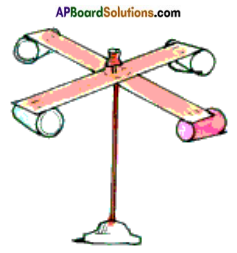
- Fix the strips at the centre, putting one over the other they make a ’+’ sign. Now fix the cups at the ends of the strips.
- Colour one cup with sketch pen. All four cups should face in the same direction.
- Push a pin through the centre of the strips and attach the strips to the sharpened pencil.
- Check that the strips rotate freely and when you blow on the cups.
- Your anemometer is ready. Counting the number of rotations for a minute will give you an estimate the speed of the wind.
- The student can thus find the speed of the wind.
Question 12.
Collect some articles and photographs from newspapers and magazines about storms and cyclones. Make a story on the basis of what you learnt in this chapter.
Answer:
This can be done by the student independently.
Question 13.
Interview eye witnesses to collect the actual experiences of people affected by a cyclone.
Answer:
A cyclonic storm creates terror. The wind flow is very high with lot of fearing sound. Small houses like huts and sheds collapsed. There is no power to know the information about cyclone. Nobody is ready to come out to rescue the victims. Heavy rain causes flooded roads. No food and no water to drink. We came outside after the cyclone. It seemed our village was a big river.
Question 14.
More fun with air.
A) Do the following activities and write your findings.
- Take an empty bottle and place it on the table as shown in figure.
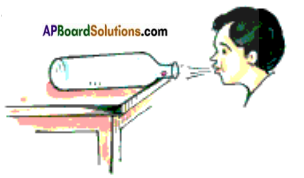
- Place a cotton ball just inside its mouth.
- Now try to blow air on the ball to send it into the bottle, and then try the activity with bottles of different sizes.
- Throw a challenge to your friends whether they can send the cotton ball inside the bottle by blowing air,
- Are you surprised? Why did this happen? Think about it and discuss with your friends.
B) Can you blow out the ball from funnel?
- Take a funnel and ball, keep the funnel in your mouth as shown in figure.
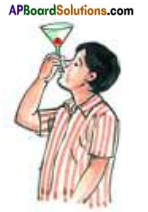
- Keep the ball in the funnel.
- Blow air through the funnel and try to send out the ball from funnel.
- It is not possible because the air blown creates a low pressure area under the ball.
- This sucks the ball in the funnel.
- And then place the ball on your hand and put the funnel over the ball as shown in figure.
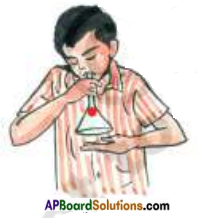
- Now blow air forcefully through funnel and try to blow out the ball from the funnel (while blowing air,m remove hand).
a) What did you observe?
b) What did you expect?
c) What happens?
Answer:
a) The ball did not fall down.
b) I expected that the ball falls,
c) The ball remained in the funnel.
C) Flow of air Experiment.
- Take a large plastic bottle and a two holed rubber cork that fits firmly into its mouth.
- Also take two glass tubes. Tie a coloured balloon to the lower end of one of the glass tubes.
- Insert the glass tubes into the two holes of the cork.
- The glass tubes should fit tightly in the holes.
- Close the mouth of the bottle with the cork and seal it with sealing wax to make the bottle airtight.
- The balloon should be inside the bottle as shown in fig.
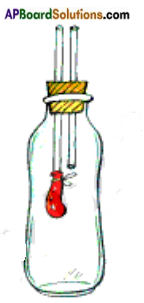
- Now suck air out of the bottle through the tube that doesn’t have a balloon attached to it.
a) What happens to the ballon?
b) Why do you think this happened?
Answer:
a) The balloon inflated.
b) 1) Inside the bottle low pressure developed. This made the air to rush into the bottle.
2) As balloon is attached to the other end of the glass tube, air enters into it and the balloon inflates.
AP Board Textbook Solutions PDF for Class 7th Science
- AP Board Class 7
- AP Board Class 7 Science
- AP Board Class 7 Science 1st Lesson Food for Health
- AP Board Class 7 Science 2nd Lesson Nature of Substances
- AP Board Class 7 Science 3rd Lesson Nutrition in Organisms
- AP Board Class 7 Science 4th Lesson Respiration and Circulation
- AP Board Class 7 Science 5th Lesson Motion and Time
- AP Board Class 7 Science 6th Lesson Electricity
- AP Board Class 7 Science 7th Lesson Reproduction in Plants
- AP Board Class 7 Science 8th Lesson Wonders of Light
- AP Board Class 7 Science 9th Lesson Heat, Temperature and Climate
- AP Board Class 7 Science 10th Lesson Changes Around Us
- AP Board Class 7 Science 11th Lesson Fibres and Fabrics
- AP Board Class 7 Science 12th Lesson Soil and Water
- AP Board Class 7 Science 1st Lesson ఆహారంతో ఆరోగ్యం
- AP Board Class 7 Science 2nd Lesson పదార్థాల స్వభావం
- AP Board Class 7 Science 3rd Lesson జీవులలో పోషణ
- AP Board Class 7 Science 4th Lesson శ్వాసక్రియ – ప్రసరణ
- AP Board Class 7 Science 5th Lesson చలనం – కాలం
- AP Board Class 7 Science 6th Lesson విద్యుత్
- AP Board Class 7 Science 7th Lesson మొక్కలలో ప్రత్యుత్పత్తి
- AP Board Class 7 Science 8th Lesson కాంతితో అద్భుతాలు
- AP Board Class 7 Science 9th Lesson ఉష్ణం, ఉష్ణోగ్రత మరియు శీతోష్ణస్థితి
- AP Board Class 7 Science 10th Lesson మన చుట్టూ జరిగే మార్పులు
- AP Board Class 7 Science 11th Lesson దారాలు – దుస్తులు
- AP Board Class 7 Science 12th Lesson నేల మరియు నీరు
- AP Board Class 7 Science Chapter 1 Food Components
- AP Board Class 7 Science Chapter 2 Acids and Bases
- AP Board Class 7 Science Chapter 3 Animal Fibre
- AP Board Class 7 Science Chapter 4 Motion and Time
- AP Board Class 7 Science Chapter 5 Temperature and Its Measurement
- AP Board Class 7 Science Chapter 6 Weather and Climate
- AP Board Class 7 Science Chapter 7 Electricity Current and Its Effect
- AP Board Class 7 Science Chapter 8 Air Winds and Cyclones
- AP Board Class 7 Science Chapter 9 Reflection of Light
- AP Board Class 7 Science Chapter 10 Nutrition in Plants
- AP Board Class 7 Science Chapter 11 Respiration in Organisms
- AP Board Class 7 Science Chapter 12 Reproduction in Plants
- AP Board Class 7 Science Chapter 13 Seed Dispersal
- AP Board Class 7 Science Chapter 14 Water Too Little To Waste
- AP Board Class 7 Science Chapter 15 Soil Our Life
- AP Board Class 7 Science Chapter 16 Forest Our Life
- AP Board Class 7 Science Chapter 17 Changes Around Us






0 Comments:
Post a Comment